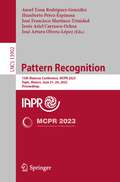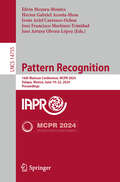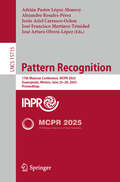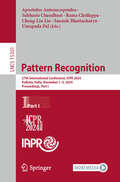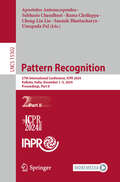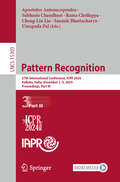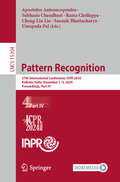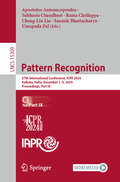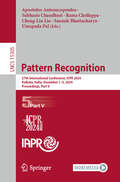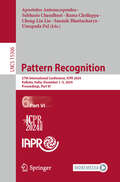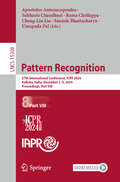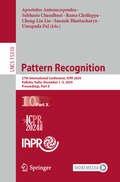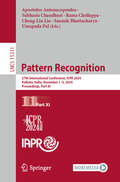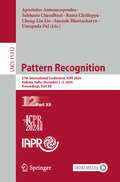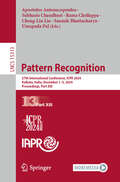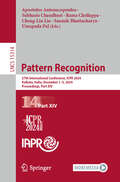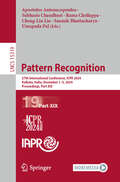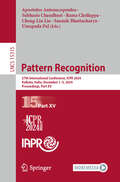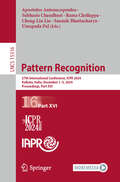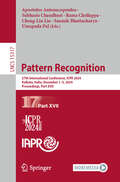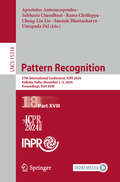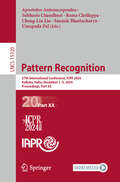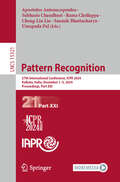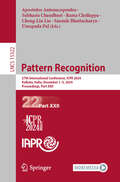- Table View
- List View
Pattern Recognition: 15th Mexican Conference, MCPR 2023, Tepic, Mexico, June 21–24, 2023, Proceedings (Lecture Notes in Computer Science #13902)
by Jesús Ariel Carrasco-Ochoa José Francisco Martínez-Trinidad José Arturo Olvera-López Ansel Yoan Rodríguez-González Humberto Pérez-EspinosaThis book constitutes the refereed proceedings of the 15th Mexican Conference on Pattern Recognition, MCPR 2023, held in Tepic, Mexico, during June 21–24, 2023.The 30 full papers presented in this book were carefully reviewed and selected from 61 submissions. The papers are divided into the following topical sections: pattern recognition and machine learning techniques; deep learning and neural networks; medical applications of pattern recognition; language processing and recognition; and industrial applications of pattern recognition.
Pattern Recognition: 16th Mexican Conference, MCPR 2024, Xalapa, Mexico, June 19–22, 2024, Proceedings (Lecture Notes in Computer Science #14755)
by Jesús Ariel Carrasco-Ochoa José Francisco Martínez-Trinidad José Arturo Olvera-López Efrén Mezura-Montes Héctor Gabriel Acosta-MesaThis book constitutes the proceedings of the 16th Mexican Conference on Pattern Recognition, MCPR 2024, held in Xalapa, Mexico, during June 19–22, 2024, Proceedings. The 36 full papers were carefully reviewed and selected from 68 submissions. The papers are organized in subject areas as follows: Pattern Recognition and Machine Learning Techniques; Computer Vision; Medical Applications of Pattern Recognition; Language Processing and Recognition; Deep Learning and Neural Networks.
Pattern Recognition: 17th Mexican Conference, MCPR 2025, Guanajuato, Mexico, June 25–28, 2025, Proceedings (Lecture Notes in Computer Science #15715)
by Jesús Ariel Carrasco-Ochoa José Francisco Martínez-Trinidad José Arturo Olvera-López Adrián Pastor López-Monroy Alejandro Rosales-PérezThis book constitutes the proceedings of the 17th Mexican Conference on Pattern Recognition, MCPR 2025, held in Guanajuato, Mexico, during June 25–28, 2025. The 36 full papers presented in this volume were carefully reviewed and selected from 70 submissions. They are grouped into the following topics: Pattern Recognition and Machine Learning Techniques; Language Processing and Recognition; Computer Vision; Medical Applications of Pattern Recognition; Reinforcement Learning; Deep Learning and Neural Networks.
Pattern Recognition: 27th International Conference, ICPR 2024, Kolkata, India, December 1–5, 2024, Proceedings, Part I (Lecture Notes in Computer Science #15301)
by Rama Chellappa Subhasis Chaudhuri Cheng-Lin Liu Umapada Pal Apostolos Antonacopoulos Saumik BhattacharyaThe multi-volume set of LNCS books with volume numbers 15301-15333 constitutes the refereed proceedings of the 27th International Conference on Pattern Recognition, ICPR 2024, held in Kolkata, India, during December 1–5, 2024. The 963 papers presented in these proceedings were carefully reviewed and selected from a total of 2106 submissions. They deal with topics such as Pattern Recognition; Artificial Intelligence; Machine Learning; Computer Vision; Robot Vision; Machine Vision; Image Processing; Speech Processing; Signal Processing; Video Processing; Biometrics; Human-Computer Interaction (HCI); Document Analysis; Document Recognition; Biomedical Imaging; Bioinformatics.
Pattern Recognition: 27th International Conference, ICPR 2024, Kolkata, India, December 1–5, 2024, Proceedings, Part II (Lecture Notes in Computer Science #15302)
by Rama Chellappa Subhasis Chaudhuri Cheng-Lin Liu Umapada Pal Apostolos Antonacopoulos Saumik BhattacharyaThe multi-volume set of LNCS books with volume numbers 15301-15333 constitutes the refereed proceedings of the 27th International Conference on Pattern Recognition, ICPR 2024, held in Kolkata, India, during December 1–5, 2024. The 963 papers presented in these proceedings were carefully reviewed and selected from a total of 2106 submissions. They deal with topics such as Pattern Recognition; Artificial Intelligence; Machine Learning; Computer Vision; Robot Vision; Machine Vision; Image Processing; Speech Processing; Signal Processing; Video Processing; Biometrics; Human-Computer Interaction (HCI); Document Analysis; Document Recognition; Biomedical Imaging; Bioinformatics.
Pattern Recognition: 27th International Conference, ICPR 2024, Kolkata, India, December 1–5, 2024, Proceedings, Part III (Lecture Notes in Computer Science #15303)
by Rama Chellappa Subhasis Chaudhuri Cheng-Lin Liu Umapada Pal Apostolos Antonacopoulos Saumik BhattacharyaThe multi-volume set of LNCS books with volume numbers 15301-15333 constitutes the refereed proceedings of the 27th International Conference on Pattern Recognition, ICPR 2024, held in Kolkata, India, during December 1–5, 2024. The 963 papers presented in these proceedings were carefully reviewed and selected from a total of 2106 submissions. They deal with topics such as Pattern Recognition; Artificial Intelligence; Machine Learning; Computer Vision; Robot Vision; Machine Vision; Image Processing; Speech Processing; Signal Processing; Video Processing; Biometrics; Human-Computer Interaction (HCI); Document Analysis; Document Recognition; Biomedical Imaging; Bioinformatics.
Pattern Recognition: 27th International Conference, ICPR 2024, Kolkata, India, December 1–5, 2024, Proceedings, Part IV (Lecture Notes in Computer Science #15304)
by Rama Chellappa Subhasis Chaudhuri Cheng-Lin Liu Umapada Pal Apostolos Antonacopoulos Saumik BhattacharyaThe multi-volume set of LNCS books with volume numbers 15301-15333 constitutes the refereed proceedings of the 27th International Conference on Pattern Recognition, ICPR 2024, held in Kolkata, India, during December 1–5, 2024. The 963 papers presented in these proceedings were carefully reviewed and selected from a total of 2106 submissions. They deal with topics such as Pattern Recognition; Artificial Intelligence; Machine Learning; Computer Vision; Robot Vision; Machine Vision; Image Processing; Speech Processing; Signal Processing; Video Processing; Biometrics; Human-Computer Interaction (HCI); Document Analysis; Document Recognition; Biomedical Imaging; Bioinformatics.
Pattern Recognition: 27th International Conference, ICPR 2024, Kolkata, India, December 1–5, 2024, Proceedings, Part IX (Lecture Notes in Computer Science #15309)
by Rama Chellappa Subhasis Chaudhuri Cheng-Lin Liu Umapada Pal Apostolos Antonacopoulos Saumik BhattacharyaThe multi-volume set of LNCS books with volume numbers 15301-15333 constitutes the refereed proceedings of the 27th International Conference on Pattern Recognition, ICPR 2024, held in Kolkata, India, during December 1–5, 2024. The 963 papers presented in these proceedings were carefully reviewed and selected from a total of 2106 submissions. They deal with topics such as Pattern Recognition; Artificial Intelligence; Machine Learning; Computer Vision; Robot Vision; Machine Vision; Image Processing; Speech Processing; Signal Processing; Video Processing; Biometrics; Human-Computer Interaction (HCI); Document Analysis; Document Recognition; Biomedical Imaging; Bioinformatics.
Pattern Recognition: 27th International Conference, ICPR 2024, Kolkata, India, December 1–5, 2024, Proceedings, Part V (Lecture Notes in Computer Science #15305)
by Rama Chellappa Subhasis Chaudhuri Cheng-Lin Liu Umapada Pal Apostolos Antonacopoulos Saumik BhattacharyaThe multi-volume set of LNCS books with volume numbers 15301-15333 constitutes the refereed proceedings of the 27th International Conference on Pattern Recognition, ICPR 2024, held in Kolkata, India, during December 1–5, 2024. The 963 papers presented in these proceedings were carefully reviewed and selected from a total of 2106 submissions. They deal with topics such as Pattern Recognition; Artificial Intelligence; Machine Learning; Computer Vision; Robot Vision; Machine Vision; Image Processing; Speech Processing; Signal Processing; Video Processing; Biometrics; Human-Computer Interaction (HCI); Document Analysis; Document Recognition; Biomedical Imaging; Bioinformatics.
Pattern Recognition: 27th International Conference, ICPR 2024, Kolkata, India, December 1–5, 2024, Proceedings, Part VI (Lecture Notes in Computer Science #15306)
by Rama Chellappa Subhasis Chaudhuri Cheng-Lin Liu Umapada Pal Apostolos Antonacopoulos Saumik BhattacharyaThe multi-volume set of LNCS books with volume numbers 15301-15333 constitutes the refereed proceedings of the 27th International Conference on Pattern Recognition, ICPR 2024, held in Kolkata, India, during December 1–5, 2024. The 963 papers presented in these proceedings were carefully reviewed and selected from a total of 2106 submissions. They deal with topics such as Pattern Recognition; Artificial Intelligence; Machine Learning; Computer Vision; Robot Vision; Machine Vision; Image Processing; Speech Processing; Signal Processing; Video Processing; Biometrics; Human-Computer Interaction (HCI); Document Analysis; Document Recognition; Biomedical Imaging; Bioinformatics.
Pattern Recognition: 27th International Conference, ICPR 2024, Kolkata, India, December 1–5, 2024, Proceedings, Part VII (Lecture Notes in Computer Science #15307)
by Rama Chellappa Subhasis Chaudhuri Cheng-Lin Liu Umapada Pal Apostolos Antonacopoulos Saumik BhattacharyaThe multi-volume set of LNCS books with volume numbers 15301-15333 constitutes the refereed proceedings of the 27th International Conference on Pattern Recognition, ICPR 2024, held in Kolkata, India, during December 1–5, 2024. The 963 papers presented in these proceedings were carefully reviewed and selected from a total of 2106 submissions. They deal with topics such as Pattern Recognition; Artificial Intelligence; Machine Learning; Computer Vision; Robot Vision; Machine Vision; Image Processing; Speech Processing; Signal Processing; Video Processing; Biometrics; Human-Computer Interaction (HCI); Document Analysis; Document Recognition; Biomedical Imaging; Bioinformatics.
Pattern Recognition: 27th International Conference, ICPR 2024, Kolkata, India, December 1–5, 2024, Proceedings, Part VIII (Lecture Notes in Computer Science #15308)
by Rama Chellappa Subhasis Chaudhuri Cheng-Lin Liu Umapada Pal Apostolos Antonacopoulos Saumik BhattacharyaThe multi-volume set of LNCS books with volume numbers 15301-15333 constitutes the refereed proceedings of the 27th International Conference on Pattern Recognition, ICPR 2024, held in Kolkata, India, during December 1–5, 2024. The 963 papers presented in these proceedings were carefully reviewed and selected from a total of 2106 submissions. They deal with topics such as Pattern Recognition; Artificial Intelligence; Machine Learning; Computer Vision; Robot Vision; Machine Vision; Image Processing; Speech Processing; Signal Processing; Video Processing; Biometrics; Human-Computer Interaction (HCI); Document Analysis; Document Recognition; Biomedical Imaging; Bioinformatics.
Pattern Recognition: 27th International Conference, ICPR 2024, Kolkata, India, December 1–5, 2024, Proceedings, Part X (Lecture Notes in Computer Science #15310)
by Rama Chellappa Subhasis Chaudhuri Cheng-Lin Liu Umapada Pal Apostolos Antonacopoulos Saumik BhattacharyaThe multi-volume set of LNCS books with volume numbers 15301-15333 constitutes the refereed proceedings of the 27th International Conference on Pattern Recognition, ICPR 2024, held in Kolkata, India, during December 1–5, 2024. The 963 papers presented in these proceedings were carefully reviewed and selected from a total of 2106 submissions. They deal with topics such as Pattern Recognition; Artificial Intelligence; Machine Learning; Computer Vision; Robot Vision; Machine Vision; Image Processing; Speech Processing; Signal Processing; Video Processing; Biometrics; Human-Computer Interaction (HCI); Document Analysis; Document Recognition; Biomedical Imaging; Bioinformatics.
Pattern Recognition: 27th International Conference, ICPR 2024, Kolkata, India, December 1–5, 2024, Proceedings, Part XI (Lecture Notes in Computer Science #15311)
by Rama Chellappa Subhasis Chaudhuri Cheng-Lin Liu Umapada Pal Apostolos Antonacopoulos Saumik BhattacharyaThe multi-volume set of LNCS books with volume numbers 15301-15333 constitutes the refereed proceedings of the 27th International Conference on Pattern Recognition, ICPR 2024, held in Kolkata, India, during December 1–5, 2024. The 963 papers presented in these proceedings were carefully reviewed and selected from a total of 2106 submissions. They deal with topics such as Pattern Recognition; Artificial Intelligence; Machine Learning; Computer Vision; Robot Vision; Machine Vision; Image Processing; Speech Processing; Signal Processing; Video Processing; Biometrics; Human-Computer Interaction (HCI); Document Analysis; Document Recognition; Biomedical Imaging; Bioinformatics.
Pattern Recognition: 27th International Conference, ICPR 2024, Kolkata, India, December 1–5, 2024, Proceedings, Part XII (Lecture Notes in Computer Science #15312)
by Rama Chellappa Subhasis Chaudhuri Cheng-Lin Liu Umapada Pal Apostolos Antonacopoulos Saumik BhattacharyaThe multi-volume set of LNCS books with volume numbers 15301-15333 constitutes the refereed proceedings of the 27th International Conference on Pattern Recognition, ICPR 2024, held in Kolkata, India, during December 1–5, 2024. The 963 papers presented in these proceedings were carefully reviewed and selected from a total of 2106 submissions. They deal with topics such as Pattern Recognition; Artificial Intelligence; Machine Learning; Computer Vision; Robot Vision; Machine Vision; Image Processing; Speech Processing; Signal Processing; Video Processing; Biometrics; Human-Computer Interaction (HCI); Document Analysis; Document Recognition; Biomedical Imaging; Bioinformatics.
Pattern Recognition: 27th International Conference, ICPR 2024, Kolkata, India, December 1–5, 2024, Proceedings, Part XIII (Lecture Notes in Computer Science #15313)
by Rama Chellappa Subhasis Chaudhuri Cheng-Lin Liu Umapada Pal Apostolos Antonacopoulos Saumik BhattacharyaThe multi-volume set of LNCS books with volume numbers 15301-15333 constitutes the refereed proceedings of the 27th International Conference on Pattern Recognition, ICPR 2024, held in Kolkata, India, during December 1–5, 2024. The 963 papers presented in these proceedings were carefully reviewed and selected from a total of 2106 submissions. They deal with topics such as Pattern Recognition; Artificial Intelligence; Machine Learning; Computer Vision; Robot Vision; Machine Vision; Image Processing; Speech Processing; Signal Processing; Video Processing; Biometrics; Human-Computer Interaction (HCI); Document Analysis; Document Recognition; Biomedical Imaging; Bioinformatics.
Pattern Recognition: 27th International Conference, ICPR 2024, Kolkata, India, December 1–5, 2024, Proceedings, Part XIV (Lecture Notes in Computer Science #15314)
by Rama Chellappa Subhasis Chaudhuri Cheng-Lin Liu Umapada Pal Apostolos Antonacopoulos Saumik BhattacharyaThe multi-volume set of LNCS books with volume numbers 15301-15333 constitutes the refereed proceedings of the 27th International Conference on Pattern Recognition, ICPR 2024, held in Kolkata, India, during December 1–5, 2024. The 963 papers presented in these proceedings were carefully reviewed and selected from a total of 2106 submissions. They deal with topics such as Pattern Recognition; Artificial Intelligence; Machine Learning; Computer Vision; Robot Vision; Machine Vision; Image Processing; Speech Processing; Signal Processing; Video Processing; Biometrics; Human-Computer Interaction (HCI); Document Analysis; Document Recognition; Biomedical Imaging; Bioinformatics.
Pattern Recognition: 27th International Conference, ICPR 2024, Kolkata, India, December 1–5, 2024, Proceedings, Part XIX (Lecture Notes in Computer Science #15319)
by Rama Chellappa Subhasis Chaudhuri Cheng-Lin Liu Umapada Pal Apostolos Antonacopoulos Saumik BhattacharyaThe multi-volume set of LNCS books with volume numbers 15301-15333 constitutes the refereed proceedings of the 27th International Conference on Pattern Recognition, ICPR 2024, held in Kolkata, India, during December 1–5, 2024. The 963 papers presented in these proceedings were carefully reviewed and selected from a total of 2106 submissions. They deal with topics such as Pattern Recognition; Artificial Intelligence; Machine Learning; Computer Vision; Robot Vision; Machine Vision; Image Processing; Speech Processing; Signal Processing; Video Processing; Biometrics; Human-Computer Interaction (HCI); Document Analysis; Document Recognition; Biomedical Imaging; Bioinformatics.
Pattern Recognition: 27th International Conference, ICPR 2024, Kolkata, India, December 1–5, 2024, Proceedings, Part XV (Lecture Notes in Computer Science #15315)
by Rama Chellappa Subhasis Chaudhuri Cheng-Lin Liu Umapada Pal Apostolos Antonacopoulos Saumik BhattacharyaThe multi-volume set of LNCS books with volume numbers 15301-15333 constitutes the refereed proceedings of the 27th International Conference on Pattern Recognition, ICPR 2024, held in Kolkata, India, during December 1–5, 2024. The 963 papers presented in these proceedings were carefully reviewed and selected from a total of 2106 submissions. They deal with topics such as Pattern Recognition; Artificial Intelligence; Machine Learning; Computer Vision; Robot Vision; Machine Vision; Image Processing; Speech Processing; Signal Processing; Video Processing; Biometrics; Human-Computer Interaction (HCI); Document Analysis; Document Recognition; Biomedical Imaging; Bioinformatics.
Pattern Recognition: 27th International Conference, ICPR 2024, Kolkata, India, December 1–5, 2024, Proceedings, Part XVI (Lecture Notes in Computer Science #15316)
by Rama Chellappa Subhasis Chaudhuri Cheng-Lin Liu Umapada Pal Apostolos Antonacopoulos Saumik BhattacharyaThe multi-volume set of LNCS books with volume numbers 15301-15333 constitutes the refereed proceedings of the 27th International Conference on Pattern Recognition, ICPR 2024, held in Kolkata, India, during December 1–5, 2024. The 963 papers presented in these proceedings were carefully reviewed and selected from a total of 2106 submissions. They deal with topics such as Pattern Recognition; Artificial Intelligence; Machine Learning; Computer Vision; Robot Vision; Machine Vision; Image Processing; Speech Processing; Signal Processing; Video Processing; Biometrics; Human-Computer Interaction (HCI); Document Analysis; Document Recognition; Biomedical Imaging; Bioinformatics.
Pattern Recognition: 27th International Conference, ICPR 2024, Kolkata, India, December 1–5, 2024, Proceedings, Part XVII (Lecture Notes in Computer Science #15317)
by Rama Chellappa Subhasis Chaudhuri Cheng-Lin Liu Umapada Pal Apostolos Antonacopoulos Saumik BhattacharyaThe multi-volume set of LNCS books with volume numbers 15301-15333 constitutes the refereed proceedings of the 27th International Conference on Pattern Recognition, ICPR 2024, held in Kolkata, India, during December 1–5, 2024. The 963 papers presented in these proceedings were carefully reviewed and selected from a total of 2106 submissions. They deal with topics such as Pattern Recognition; Artificial Intelligence; Machine Learning; Computer Vision; Robot Vision; Machine Vision; Image Processing; Speech Processing; Signal Processing; Video Processing; Biometrics; Human-Computer Interaction (HCI); Document Analysis; Document Recognition; Biomedical Imaging; Bioinformatics.
Pattern Recognition: 27th International Conference, ICPR 2024, Kolkata, India, December 1–5, 2024, Proceedings, Part XVIII (Lecture Notes in Computer Science #15318)
by Rama Chellappa Subhasis Chaudhuri Cheng-Lin Liu Umapada Pal Apostolos Antonacopoulos Saumik BhattacharyaThe multi-volume set of LNCS books with volume numbers 15301-15333 constitutes the refereed proceedings of the 27th International Conference on Pattern Recognition, ICPR 2024, held in Kolkata, India, during December 1–5, 2024. The 963 papers presented in these proceedings were carefully reviewed and selected from a total of 2106 submissions. They deal with topics such as Pattern Recognition; Artificial Intelligence; Machine Learning; Computer Vision; Robot Vision; Machine Vision; Image Processing; Speech Processing; Signal Processing; Video Processing; Biometrics; Human-Computer Interaction (HCI); Document Analysis; Document Recognition; Biomedical Imaging; Bioinformatics.
Pattern Recognition: 27th International Conference, ICPR 2024, Kolkata, India, December 1–5, 2024, Proceedings, Part XX (Lecture Notes in Computer Science #15320)
by Rama Chellappa Subhasis Chaudhuri Cheng-Lin Liu Umapada Pal Apostolos Antonacopoulos Saumik BhattacharyaThe multi-volume set of LNCS books with volume numbers 15301-15333 constitutes the refereed proceedings of the 27th International Conference on Pattern Recognition, ICPR 2024, held in Kolkata, India, during December 1–5, 2024. The 963 papers presented in these proceedings were carefully reviewed and selected from a total of 2106 submissions. They deal with topics such as Pattern Recognition; Artificial Intelligence; Machine Learning; Computer Vision; Robot Vision; Machine Vision; Image Processing; Speech Processing; Signal Processing; Video Processing; Biometrics; Human-Computer Interaction (HCI); Document Analysis; Document Recognition; Biomedical Imaging; Bioinformatics.
Pattern Recognition: 27th International Conference, ICPR 2024, Kolkata, India, December 1–5, 2024, Proceedings, Part XXI (Lecture Notes in Computer Science #15321)
by Rama Chellappa Subhasis Chaudhuri Cheng-Lin Liu Umapada Pal Apostolos Antonacopoulos Saumik BhattacharyaThe multi-volume set of LNCS books with volume numbers 15301-15333 constitutes the refereed proceedings of the 27th International Conference on Pattern Recognition, ICPR 2024, held in Kolkata, India, during December 1–5, 2024. The 963 papers presented in these proceedings were carefully reviewed and selected from a total of 2106 submissions. They deal with topics such as Pattern Recognition; Artificial Intelligence; Machine Learning; Computer Vision; Robot Vision; Machine Vision; Image Processing; Speech Processing; Signal Processing; Video Processing; Biometrics; Human-Computer Interaction (HCI); Document Analysis; Document Recognition; Biomedical Imaging; Bioinformatics.
Pattern Recognition: 27th International Conference, ICPR 2024, Kolkata, India, December 1–5, 2024, Proceedings, Part XXII (Lecture Notes in Computer Science #15322)
by Rama Chellappa Subhasis Chaudhuri Cheng-Lin Liu Umapada Pal Apostolos Antonacopoulos Saumik BhattacharyaThe multi-volume set of LNCS books with volume numbers 15301-15333 constitutes the refereed proceedings of the 27th International Conference on Pattern Recognition, ICPR 2024, held in Kolkata, India, during December 1–5, 2024. The 963 papers presented in these proceedings were carefully reviewed and selected from a total of 2106 submissions. They deal with topics such as Pattern Recognition; Artificial Intelligence; Machine Learning; Computer Vision; Robot Vision; Machine Vision; Image Processing; Speech Processing; Signal Processing; Video Processing; Biometrics; Human-Computer Interaction (HCI); Document Analysis; Document Recognition; Biomedical Imaging; Bioinformatics.
